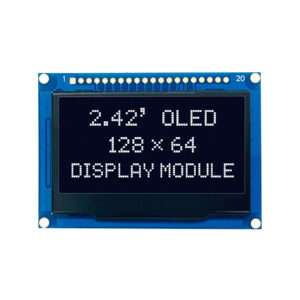
Great things in business are never done by one person. They’re done by a team of people. We have that dynamic group of peoples
Liquid Crystal Displays (LCDs) are ubiquitous in modern technology, from our smartphones to our televisions. This article delves deep into the fascinating world of LCD technology, explaining how these displays work, the science behind them, and why they’ve become so widespread. If you’ve ever wondered how a flat screen shows images or want to understand the differences between different display types, this is the perfect read for you.
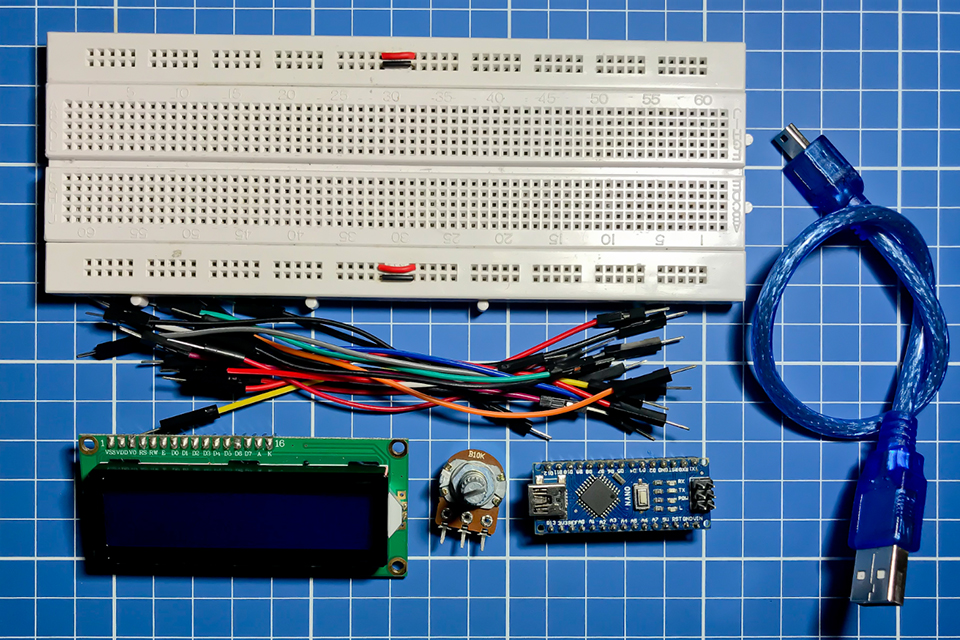
An LCD, or Liquid Crystal Display, is a type of flat panel display that uses the properties of liquid crystals to control light and create images. Unlike older display technologies like CRT (Cathode Ray Tube) monitors, which emitted light directly, LCDs rely on an external light source, the backlight, to illuminate pixels. The lcd itself does not generate light; instead, it manipulates light passes through the liquid crystals to form the visible images on the lcd screen. The lcd technology differs significantly from technologies such as OLED (oled display), which does emit light from each pixel.
The lcd display consists of several layers, including the liquid crystal material sandwiched between two glass substrates. This makes the lcd a passive display requiring an external light source. In an LCD, the liquid crystal layer’s orientation can be altered by applying a voltage, which then affects the way light passes through the display. The primary difference compared to older display technologies lies in the method of creating light; older display technologies would emit light directly, while lcd technology manipulates light from a backlight. This distinction allows LCDs to be much thinner and consume less power.
Liquid crystals are the core of lcd technology. They are a unique state of matter that exhibits properties between conventional liquids and solid crystals. These molecules are rod-shaped and can be aligned in an orderly way, like a crystal, but they also flow like a liquid. This alignment can be controlled by applying an electric current through the liquid. In an lcd, liquid crystal molecules are used to manipulate the light coming from the backlight. This is the fundamental principle of how lcd devices work.
Specifically, liquid crystals are arranged in a layer, often called the liquid crystal layer, between two layers of glass. The liquid crystals have a natural tendency to twist along the path of light passes through them. When a voltage is applied to an electrode, which is also a component of the lcd, the alignment of liquid crystal molecules changes. The liquid crystals control how much light can pass through the lcd which, therefore, determines the brightness of the pixel. Without liquid crystals, lcds wouldn’t be able to control the flow of light. Therefore, the unique ability of liquid crystals to change their arrangement based on voltage is vital for lcds work.
The backlight is a crucial component of an lcd, as liquid crystals do not emit light. The backlight provides a consistent light source that illuminates the liquid crystals from behind. Without a backlight, the lcd screen would appear dark. The backlight illuminates the liquid crystals and the subsequent filter, which allows the viewer to see an image. Common backlight sources include fluorescent lamps and, more recently, light-emitting diodes (LEDs). LEDs are now more commonly used due to their efficiency, brightness, and long lifespan.
The primary role of the backlight is to illuminate the lcd panel evenly, ensuring uniform brightness across the entire display. Different lcd display models may use different types of backlights depending on factors such as cost, power consumption and required brightness. The type of backlight can also influence other parameters of the display, like the response time. Since lcds use a backlight for illumination, the uniformity and quality of the backlight directly impacts the quality of the visible image and is one of the critical components of an lcd. This ensures that all the pixels on the screen are adequately lit, enabling a clear image to form.
An lcd consists of several key components working together to produce an image. The most important components of an lcd include: the backlight, the two glass substrate layers, the liquid crystal layer, the polarizing filter, and the color filter. The backlight, as we know, provides the light source. The liquid crystal layer, made up of liquid crystals, is placed between two layers of glass substrate. On either side of this assembly are the polarizing filter layers and color filter. Each of these components plays a vital role in creating the final image.
The components of an lcd function in a coordinated manner. The backlight shines light through the first polarizing filter. Then light passes through the liquid crystal layer. By applying voltage, the orientation of liquid crystals is modified, which then alters how light passes through the liquid crystal layer. The final color filter layer consists of tiny red, green and blue filters, that when combined, create the wide range of colors visible on the lcd screen. All of these components of an lcd operate in tandem, enabling the precise control of the light that produces the final image.
A polarizing filter is essential to the operation of an lcd, as it works with the liquid crystal layer to control how light passes through the display. Light, before hitting the lcd is unpolarized meaning it vibrates in all directions. The first polarizing filter, located at the bottom of the display, allows only light vibrating in one direction to pass. This polarized light then goes through the liquid crystals. When no voltage is applied the liquid crystal molecules twist the polarized light by 90 degrees.
The second polarizing filter, located on top of the liquid crystal layer, is oriented to block polarized light that has passed through the first polarizing filter and then through the liquid crystals. When no voltage is applied, the twisted light from the liquid crystals is aligned with the top polarizing filter allowing the light to pass. When voltage is applied however, the liquid crystals no longer twist the light causing it to be blocked by the second polarizing filter. The polarizing filter thus controls how much light reaches the viewer, and together with the liquid crystals, enables the creation of images. The specific orientation and interaction between polarizing filters are key to the function of lcd technology.
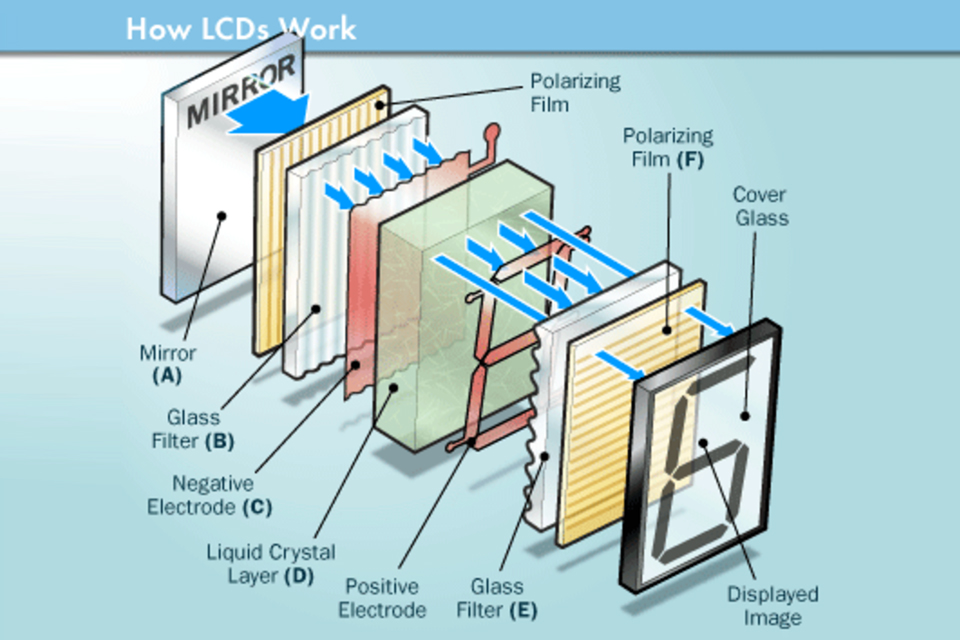
A TFT lcd display uses a thin film transistor for each pixel on the lcd screen, acting as an individual switch. This allows for more precise control of the light and improved response time compared to older lcd technologies. The TFT layer is an active matrix, enabling each pixel to be controlled independently. In a TFT lcd display, the transistor switches the voltage to the liquid crystal layer for each individual pixel, and this is how we can individually adjust every pixel on the display.
The transistor in a tft lcd display ensures that each pixel can be quickly turned on or off, and that the intended brightness and display color are displayed accurately. The individual transistor control of each pixel also eliminates issues like ghosting or blurring, common in older, passive matrix lcd technology. The tft technology has significantly improved the performance of lcds, making them suitable for high-resolution and fast-motion video. The introduction of TFT technology was a crucial step in advancing lcd technology, improving the image quality, and enabling the modern lcds used in a multitude of electronic devices.
Pixels are the smallest controllable elements on an lcd screen. They are the fundamental building blocks of any image on the display. Each pixel is essentially a tiny area on the lcd panel that can individually control the amount of light passing through it. In a color lcd, each pixel is further divided into sub-pixels, which are usually red, green, and blue. The different colors and shades we see on the screen are made by combining varying levels of brightness from each red, green, and blue sub-pixel. The number of pixels on the display (the resolution), determines the clarity and detail of the image.
Each sub-pixel on the display has its own dedicated liquid crystal and color filter. By adjusting the voltage applied to each sub-pixel, we control the amount of light that goes through its corresponding filter. The color filter is a crucial component that generates colors by letting only the selected wavelength of light to pass through, and the resulting combination of red, green, and blue light creates a wide spectrum of color on the lcd. For example, if only the red sub-pixel is turned on, the pixel will appear red. If all three are turned on at high brightness, the pixel will appear white. This combination is how the lcd achieves its wide range of display color.
There are several different types of lcd technologies, each with its own advantages and specific applications. One of the most common type of lcd is the tft lcd display, discussed earlier, which is widely used in laptops, smartphones, and television because of its high resolution and fast response time. Another type is the Twisted Nematic (TN) display, which offers quick response time, however, it is usually limited in the viewing angle. These TN lcds are one of the most common type of lcd. Other different liquid crystal technologies offer benefits in areas such as wide viewing angle, contrast ratio, and color reproduction.
The lcd technology is adaptable to a variety of applications. Tft lcd displays are prevalent in consumer electronics, while simpler lcds may be used in digital clocks and basic display panels. Some lcds are designed to be especially rugged for outdoor lcd installations, like digital signage, where durability and visibility in direct sunlight are essential. The choice of type of lcd depends on the intended application and the specific performance requirements. Understanding these variations is crucial when choosing the appropriate lcd display for a particular device or usage. The adaptability of lcds is what makes them suitable for a diverse range of display devices.
The function of an lcd, from start to final image, involves several steps working in conjunction. First, the backlight produces a uniform light source, which then passes through the first polarizing filter. This initial filter polarizes the light, causing it to vibrate in one direction. Next, the polarized light passes through the liquid crystal layer. In the absence of an electric current, the nematic liquid crystal molecules twist, which causes the light passing through them to rotate by 90 degrees.
If voltage is applied to a particular area, the liquid crystal molecules realign, preventing light from rotating. When the light emerges from the liquid crystal layer, it goes to the second polarizing filter. This filter is oriented to block light when no voltage was applied to the liquid crystal. Finally, the light passes through the lcd’s color filter, where each sub-pixel (red, green, and blue) allows a specific color of light to pass. These sub-pixels work together to create the overall display color. When combined, the different sub-pixels work together to create the final image we see on the lcd screen.
Lcds offer numerous advantages, which is why they are so prevalent in display technologies. One of the main advantages is their slim profile and lightweight nature, due to the thin film structure used in the tft lcd panel. They also consume less power than older display technologies, contributing to energy efficiency. Lcds can produce high-resolution images and can have a very high contrast ratio, which ensures sharp and clear text and images. Their versatility makes them suitable for different applications.
The reasons for their common use in digital signage specifically include their high brightness capabilities, especially for outdoor lcd installations. Lcds can display vibrant colors and sharp images that are visible in a range of lighting conditions. Moreover, lcd modules are reliable and relatively low-maintenance, which is a plus for digital signage where minimal downtime is crucial. These advantages, paired with their cost effectiveness and scalability, are why lcds are often the technology of choice for digital signage, in consumer electronics, and several other areas where a visible display is required.

Table 1: Comparison of LCD Components
| Component | Function |
|---|---|
| Backlight | Provides the light source for the display |
| Polarizing Filter | Polarizes light and works with liquid crystals to control the light |
| Liquid Crystal Layer | Alters the polarization of light based on applied voltage |
| Color Filter | Adds color to the light using red, green and blue sub- filters |
| Transistor | Controls the voltage to individual pixels in tft displays |
Table 2: Common LCD Applications
| Application | LCD Technology |
|---|---|
| Smartphones | TFT LCD display, OLED for some high end phones |
| Laptops | TFT LCD display |
| Television | TFT LCD display, color lcd |
| Digital Signage | High brightness lcd, outdoor lcd |
| Digital Clocks | Basic lcds |
| Digital Cameras | TFT LCD displays |

Are you confused by all the different display technologies out there? From LCD to OLED, and even further, to AMOLED and Super AMOLED, the choices can be overwhelming.
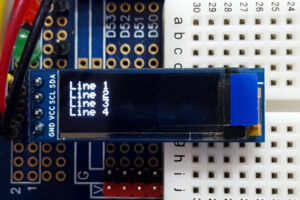
This article delves into the world of compact OLED display modules, specifically focusing on the 0.91 inch 128×32 OLED display that utilizes the I2C interface.

This article dives deep into the world of micro-OLED and microLED microdisplays, exploring their technology, applications, and the significant role they play in shaping the future of AR and VR, especially in devices like the Apple Vision Pro.

This article dives into the world of LCD screen repair, providing you with a comprehensive understanding of the issues you might encounter with a broken or cracked screen, how to identify them, and the best solutions available.

This article explores how to connect an LCD screen to a Raspberry Pi using an HDMI driver board, essentially turning your single-board computer into a miniature HDMI monitor.
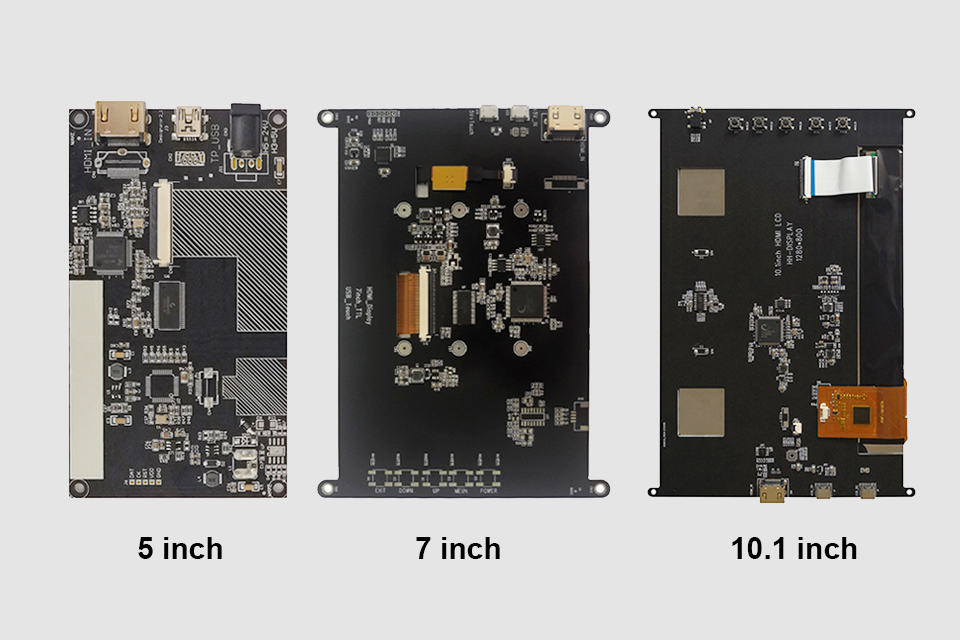
This article explores how to connect an LCD screen to a Raspberry Pi using an HDMI driver board, essentially turning your single-board computer into a miniature HDMI monitor.

This article dives into the exciting world of augmented reality (ar) lenses, specifically focusing on the development and potential of an interchangeable lens system for ar glasses.

This article dives deep into the lifespan and durability of OLED (Organic Light Emitting Diode) displays compared to LCD (Liquid Crystal Display) screens.

@ 2025 display-module. All right reserved.
Fill out the form below, and we will be in touch shortly.